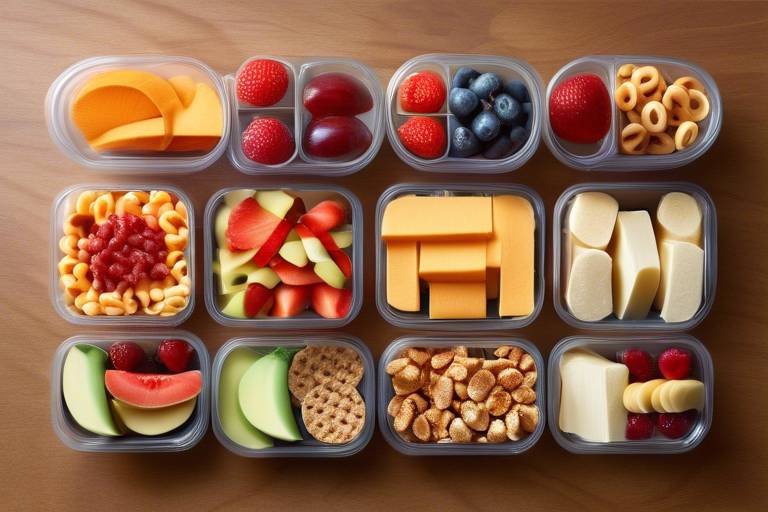Planning Meals for a Family with Different Dietary Needs
Meal planning can often feel like juggling a dozen balls at once, especially when you're catering to a family with a variety of dietary needs. It's like trying to create a masterpiece where each brushstroke represents a different preference or restriction. But fear not! With a little creativity and organization, you can whip up meals that are not only nutritious but also delicious and satisfying for everyone at the table. In this article, we will explore effective strategies for planning meals that accommodate diverse dietary preferences and restrictions, ensuring that every family member enjoys their food.
Understanding the unique dietary needs of your family is just the first step in this culinary adventure. You might have a member who is gluten-intolerant, another who is a dedicated vegan, and yet another who simply prefers low-carb meals. These varying requirements can create a complex landscape to navigate, but with some thoughtful planning, you can create a meal plan that feels inclusive and exciting.
Imagine sitting down for dinner and seeing smiles all around the table, each person enjoying a meal tailored to their needs. That's the goal! So, let's dive into the world of meal planning and discover how to make it work for your family.
Recognizing the various dietary restrictions within a family is crucial. This section discusses common dietary needs, including allergies, intolerances, and lifestyle choices, helping to create a foundational understanding for meal planning. It's essential to have an open line of communication with your family members about their dietary preferences and any restrictions they might have. This way, you can avoid potential pitfalls, like accidentally serving a dish that contains allergens or ingredients that just don’t sit well with someone.
A well-structured meal plan simplifies the cooking process. Here, we will outline steps for designing a weekly meal plan that incorporates everyone's dietary preferences while ensuring variety and nutrition. Start by gathering input from your family. What are their favorite meals? Are there any new recipes they’ve been wanting to try? This collaborative approach not only makes everyone feel involved but also helps in generating excitement for the week ahead.
Variety is essential in meal planning to prevent monotony. Think of it as a colorful palette; the more colors you have, the more vibrant your painting will be. Introduce diverse ingredients and cuisines that cater to different tastes and dietary restrictions. For instance, if you have a family member who loves Italian food but another who is on a ketogenic diet, you might whip up a zoodle (zucchini noodle) dish with a rich tomato sauce that everyone can enjoy.
Using seasonal ingredients not only enhances flavor but also supports local farmers. Think of the taste of fresh tomatoes in summer or the crispness of apples in autumn. This part discusses how to select fresh, seasonal produce that aligns with various dietary needs for optimal nutrition. Not only does this practice benefit your family's health, but it also contributes to a more sustainable food system.
Effective meal prep can save time and reduce stress. Imagine coming home after a long day and knowing that a delicious, healthy meal is just a few minutes away. Here, we explore practical meal prep strategies that accommodate different dietary requirements, making it easier to maintain a balanced diet. Consider prepping ingredients ahead of time, such as chopping vegetables or marinating proteins, so that when it’s time to cook, you can focus on bringing everything together.
This section focuses on how to tailor meals for specific diets, such as vegan, gluten-free, or ketogenic. We will provide insights on substitutions and modifications to ensure everyone is satisfied. For example, if you’re making tacos, you can use corn tortillas for gluten-free family members, while providing a hearty bean filling for vegans and a meat option for others. It’s all about finding common ground while respecting individual preferences.
Involving family members in the meal planning process fosters collaboration and understanding. This section discusses strategies for encouraging family participation, ensuring everyone feels included in their dietary choices. You might set aside a day each week for a family meeting where everyone can share their ideas and preferences. This not only builds excitement but also teaches children valuable skills in planning and nutrition.
Cooking together can be a fun family activity. Think of it as a bonding experience that allows you to create memories while preparing meals. This part emphasizes the benefits of preparing meals as a group, promoting teamwork and teaching valuable cooking skills to children. Imagine the laughter and joy as everyone pitches in, each contributing their unique touch to the meal.
Soliciting feedback on meals is essential for continuous improvement. Here, we discuss how to gather input from family members to make necessary adjustments to future meal plans, ensuring satisfaction for all. After each meal, take a moment to ask what everyone enjoyed or if there’s anything they would like to change next time. This not only helps in refining your meal planning skills but also shows your family that their opinions matter.
Q: How can I ensure my meal plan is balanced?
A: Focus on incorporating a variety of food groups, including proteins, vegetables, fruits, grains, and healthy fats. Aim for colorful plates!
Q: What if someone in my family is a picky eater?
A: Try to include familiar foods alongside new ones. Involve them in the meal planning process to encourage them to try different dishes.
Q: How can I save time with meal prep?
A: Consider batch cooking on weekends, using leftovers creatively, and prepping ingredients in advance to streamline your cooking process during the week.

Understanding Dietary Restrictions
Recognizing the various dietary restrictions within a family is crucial for meal planning. This understanding not only helps in creating meals that everyone can enjoy but also fosters a sense of inclusivity and care among family members. Dietary restrictions can arise from a variety of sources, including allergies, intolerances, and personal lifestyle choices. It's like trying to piece together a puzzle where each family member has a unique shape that needs to fit perfectly into the overall picture of family meals.
Common dietary needs can be categorized into several groups, including:
- Food Allergies: These are serious reactions to specific foods, such as nuts, shellfish, or dairy. Even a tiny amount can lead to severe consequences, so understanding and accommodating these allergies is non-negotiable.
- Food Intolerances: Unlike allergies, intolerances may not trigger an immediate reaction, but they can cause discomfort over time. Lactose intolerance is a common example, where dairy products can lead to digestive issues.
- Dietary Preferences: Some family members may choose to follow specific diets for ethical, health, or religious reasons. This includes vegetarianism, veganism, or even gluten-free diets.
Understanding these dietary restrictions requires open communication within the family. It’s important to have conversations about what each person can and cannot eat. For instance, if someone in the family is gluten intolerant, it’s essential to explore gluten-free grains like quinoa or rice as substitutes in meals. This proactive approach not only helps in meal preparation but also shows respect for each person's choices and needs.
Moreover, it's beneficial to keep a list of these dietary restrictions handy. This can be a simple table that outlines each family member's needs, making it easier to reference while planning meals. Here's a sample format:
| Family Member | Dietary Restriction |
|---|---|
| Mom | Gluten-Free |
| Dad | Nuts Allergy |
| Child 1 | Vegetarian |
| Child 2 | Dairy Intolerance |
By creating a foundational understanding of these dietary restrictions, families can work together to ensure that everyone enjoys nutritious and satisfying meals tailored to their individual needs. It's all about finding that sweet spot where everyone’s dietary preferences and restrictions are considered, making meal times a delightful experience rather than a source of stress.
Q: How can I effectively communicate my dietary needs to my family?
A: Open and honest communication is key. Share your dietary restrictions clearly and explain why they are important to you. This helps family members understand your needs better.
Q: What should I do if my family is resistant to changing meal plans?
A: Involve them in the meal planning process. Ask for their input on meals, and be open to trying new recipes that accommodate everyone's needs.
Q: Are there resources available to help with meal planning for diverse diets?
A: Absolutely! There are many websites, cookbooks, and apps designed to help families create meal plans that cater to various dietary restrictions. Exploring these resources can provide inspiration and guidance.

Creating a Meal Plan
Creating a meal plan might seem like a daunting task, especially when you're juggling the diverse dietary needs of your family. However, with a little organization and creativity, you can craft a meal plan that not only satisfies everyone's preferences but also keeps mealtime exciting. Think of meal planning as a puzzle; each piece represents a different dietary need, and when you fit them together just right, you create a beautiful picture of health and happiness on your dining table.
To start, it's essential to gather input from all family members regarding their likes, dislikes, and any specific dietary restrictions they may have. This collaborative approach not only ensures that everyone feels included but also helps to avoid the dreaded "what's for dinner?" question that often leads to frustration. You might want to consider setting up a family meeting or even a fun family survey to collect this information. Once you have a clear understanding of everyone's needs, you can begin to outline your meal plan.
Next, it's beneficial to choose a specific day of the week to sit down and plan your meals. This could be a Sunday afternoon or any day that works best for your family. During this planning session, you can create a weekly menu that includes breakfast, lunch, and dinner. Make sure to incorporate a variety of proteins, vegetables, and grains to keep meals balanced and nutritious. For example, you might plan a quinoa salad with grilled chicken for one night, and a hearty vegetable stir-fry with tofu for another.
When crafting your meal plan, consider using a table to visualize your week. Here’s a simple structure to get you started:
| Day | Breakfast | Lunch | Dinner |
|---|---|---|---|
| Monday | Oatmeal with fruits | Turkey wrap | Grilled salmon with asparagus |
| Tuesday | Smoothie bowl | Quinoa salad | Vegetable stir-fry |
| Wednesday | Scrambled eggs | Chickpea salad | Pasta with marinara sauce |
| Thursday | Yogurt with granola | Leftover stir-fry | Taco night |
| Friday | Fruit and nut bar | Caprese sandwich | Homemade pizza |
As you plan, keep in mind the importance of incorporating leftovers into your strategy. This not only reduces food waste but also saves time on busy nights. For instance, if you make a large batch of chili on Monday, you can serve it for lunch on Tuesday or even transform it into a chili-stuffed baked potato for dinner later in the week. The key is to be flexible and creative with your meals.
Lastly, don't forget to consider snacks and beverages in your meal plan. Healthy snacks can help keep energy levels up and prevent unhealthy munching. Think about including options like fresh fruits, nuts, or yogurt, which can cater to various dietary needs. By planning for meals and snacks alike, you’ll create a comprehensive approach that keeps everyone satisfied and nourished throughout the day.
In conclusion, creating a meal plan is not just about organizing meals; it’s about bringing the family together and ensuring that everyone enjoys what’s on their plate. With a little effort and creativity, you can design a meal plan that accommodates different dietary needs while keeping mealtime fun and flavorful!
- How can I accommodate food allergies in my meal plan? - Make sure to identify all allergens and substitute ingredients accordingly. Always read labels carefully.
- What if my family members have conflicting dietary preferences? - Focus on creating base meals that can be customized for each person. For example, a taco night can include various toppings for different diets.
- How can I involve kids in the meal planning process? - Encourage them to choose their favorite meals or let them help with simple cooking tasks to make them feel included.

Incorporating Variety
When it comes to meal planning for a family with diverse dietary needs, variety is not just the spice of life; it’s a crucial ingredient for maintaining interest and enthusiasm at the dinner table. Think about it: would you want to eat the same thing every day? Probably not! Incorporating a range of ingredients and cuisines not only caters to different tastes but also ensures that everyone gets the nutrients they need. So, how do we jazz things up in the kitchen while keeping everyone satisfied? Let's dive in!
First off, consider the power of global cuisines. Each culture has its unique flavors and cooking techniques that can make meals exciting. For instance, if one family member is gluten-free, you might explore Italian cuisine with gluten-free pasta or a hearty Thai curry served with rice. This not only accommodates dietary restrictions but also introduces everyone to new flavors and textures. You can even make it a fun family challenge to try a different cuisine each week!
Another effective way to incorporate variety is through the use of seasonal ingredients. Seasonal produce is often fresher, tastier, and more nutritious. Plus, it’s a fantastic way to support local farmers and reduce your carbon footprint. For example, in the summer, you might find an abundance of tomatoes, zucchini, and peppers. You could whip up a vibrant ratatouille that satisfies both vegan and non-vegan family members alike. By planning meals around what’s in season, you can create dishes that not only taste better but also celebrate the changing seasons.
Don’t forget about the power of color in your meals! A plate filled with a rainbow of fruits and vegetables is not only visually appealing but also indicates a variety of nutrients. Try to include different colored foods in your meals, such as red bell peppers, green broccoli, yellow squash, and purple eggplant. This not only makes your meals more attractive but also ensures a wider range of vitamins and minerals. Remember, eating the rainbow is not just a catchy phrase; it’s a great guideline for balanced nutrition!
To help keep things organized, consider creating a meal rotation schedule. This can be as simple as a table that outlines different meals for each day of the week. By having a structured plan, you can easily incorporate various dishes without falling into the trap of repetition. Here’s a quick example:
| Day | Main Dish | Dietary Considerations |
|---|---|---|
| Monday | Chickpea Stir-Fry | Vegan, Gluten-Free |
| Tuesday | Grilled Chicken Tacos | Low-Carb, Dairy-Free |
| Wednesday | Pasta Primavera | Vegetarian, Nut-Free |
| Thursday | Quinoa Salad | Gluten-Free, Vegan |
| Friday | Homemade Pizza | Customizable for All Diets |
By utilizing a meal rotation, you can ensure that every family member has something they enjoy while still exploring new flavors. So, the next time you sit down to plan your meals, remember to think outside the box! Variety is key to keeping everyone happy and healthy, and with a little creativity, you can make each meal an exciting culinary adventure.
Q: How can I accommodate picky eaters while incorporating variety?
A: Start by involving them in the meal planning process. Ask for their input on what they’d like to try, and consider making a “build-your-own” meal night where everyone can customize their plates.
Q: What are some easy ways to introduce new ingredients?
A: Start small! Introduce one new ingredient at a time and pair it with familiar foods. You could also try incorporating new ingredients into favorite recipes to ease the transition.
Q: How do I ensure nutritional balance with diverse meals?
A: Focus on including a source of protein, healthy fats, and a variety of fruits and vegetables in each meal. Using a meal planning tool or app can also help you keep track of nutritional content.

Seasonal Ingredients
When it comes to meal planning, using can be a game changer. Not only do they enhance the flavor of your dishes, but they also offer a plethora of nutritional benefits. Imagine biting into a juicy, sun-ripened tomato in the summer or enjoying a warm, hearty squash soup in the fall. Seasonal produce is at its peak freshness, which means you’re getting the best taste and the most nutrients. Furthermore, supporting local farmers by choosing seasonal ingredients helps sustain your community and reduces the carbon footprint associated with transporting food long distances.
Understanding which ingredients are in season can empower you to make better meal choices. For example, during the spring, you might find an abundance of asparagus, peas, and strawberries, while summer brings forth zucchini, bell peppers, and berries. In the fall, root vegetables like carrots, beets, and pumpkins take center stage, and winter often features hearty greens like kale and collard greens. By incorporating these seasonal items into your meal plan, you can create a colorful and diverse menu that caters to everyone’s tastes.
Here’s a quick overview of some seasonal ingredients by season:
| Season | Fruits | Vegetables |
|---|---|---|
| Spring | Strawberries, Cherries | Asparagus, Peas, Spinach |
| Summer | Watermelon, Peaches | Tomatoes, Cucumbers, Bell Peppers |
| Fall | Apples, Pears | Squash, Carrots, Brussels Sprouts |
| Winter | Citrus Fruits, Pomegranates | Kale, Root Vegetables |
Incorporating these seasonal ingredients into your meals not only keeps things exciting but also ensures that your family is consuming a balanced diet rich in vitamins and minerals. Additionally, seasonal cooking can inspire you to try new recipes and experiment with different cuisines. For instance, you could whip up a delightful summer salad featuring fresh tomatoes, basil, and mozzarella or a comforting winter stew packed with root vegetables and herbs. The possibilities are endless!
So, the next time you sit down to plan your meals, consider the seasonality of the ingredients available. Not only will your dishes taste better, but you’ll also be doing your part to support sustainable practices and promote a healthy lifestyle for your family.
- What are seasonal ingredients? Seasonal ingredients are fruits and vegetables that are harvested during specific times of the year, ensuring peak freshness and flavor.
- How can I find out what’s in season in my area? You can check local farmers' markets, agricultural extension websites, or seasonal produce guides specific to your region.
- Why should I use seasonal ingredients? Using seasonal ingredients can enhance flavor, increase nutritional value, support local farmers, and reduce environmental impact.

Meal Prep Strategies
Meal prepping can feel like a daunting task, especially when you're catering to a family with varied dietary needs. However, with the right strategies in place, it can transform into a rewarding and efficient process. The key is to approach meal prep with a flexible mindset, ensuring that you accommodate everyone's preferences while keeping the meals nutritious and exciting.
First off, start by planning your meals for the week. Dedicate some time each weekend to map out what you’ll be cooking. This not only saves time during the week but also reduces the stress of last-minute decisions. Consider creating a simple table to outline your meals. For example:
| Day | Meal | Dietary Needs |
|---|---|---|
| Monday | Vegetable Stir-fry | Vegan, Gluten-Free |
| Tuesday | Chicken Tacos | Low-Carb, Dairy-Free |
| Wednesday | Quinoa Salad | Vegetarian, Nut-Free |
| Thursday | Beef Stew | Gluten-Free |
| Friday | Homemade Pizza | Vegetarian, Dairy-Free Option |
Next, consider batch cooking. This means preparing larger quantities of certain ingredients or meals that can be used throughout the week. For instance, cook a big pot of quinoa or brown rice, which can serve as a base for various dishes. You can use it in salads, stir-fries, or as a side for proteins. This not only saves time but also ensures that you have a healthy option ready to go when hunger strikes.
Another effective strategy is to invest in good storage containers. Having a variety of sizes can help you portion out meals easily, making it convenient to grab-and-go. Clear containers allow you to see what you have at a glance, which can help you avoid food waste and keep your meals organized. Labeling these containers can also be a game-changer, especially when different family members have different preferences. You can use a simple label maker or even masking tape and a marker!
Don’t forget about freezing meals. If you prepare extra portions, freezing them can be a lifesaver on busy nights. Just make sure to use freezer-safe containers and label them with the date and contents. This way, you’ll have a stockpile of meals ready to heat up whenever you need them. Consider dedicating a section of your freezer specifically for these prepped meals to keep things neat and organized.
Lastly, involve the family in the meal prep process. Not only does this make it more enjoyable, but it also gives everyone a sense of ownership over the meals. You can assign tasks based on age and skill level—little ones can help wash vegetables, while older kids can chop or measure ingredients. This not only teaches valuable cooking skills but also fosters a sense of teamwork and collaboration in the kitchen.
In conclusion, meal prep doesn’t have to be a chore. By planning ahead, batch cooking, investing in the right tools, and involving the family, you can create a seamless meal prep routine that caters to everyone's dietary needs. So roll up your sleeves, grab those ingredients, and get cooking!
- What are some easy meal prep ideas for beginners? Start with simple recipes like stir-fries, salads, or casseroles that can be easily scaled up.
- How can I ensure my meal prep is healthy? Focus on incorporating a variety of vegetables, lean proteins, and whole grains into your meals.
- How long can I store meal prepped food? Generally, most cooked meals can be stored in the refrigerator for up to 4 days or in the freezer for up to 3 months.
- Can I meal prep for special diets? Absolutely! Just make sure to research appropriate substitutions and ingredients for each dietary restriction.

Accommodating Special Diets
When it comes to meal planning for a family with diverse dietary needs, is not just a necessity, but an adventure in creativity and inclusivity. Whether you have a family member who is vegan, gluten-free, or following a ketogenic lifestyle, there are ways to ensure that everyone can enjoy delicious meals together. The key is understanding the fundamentals of each diet and finding suitable substitutions that maintain flavor and satisfaction.
First, let’s delve into some popular dietary preferences and how to cater to them:
- Vegan: For those who avoid all animal products, focus on plant-based proteins like beans, lentils, and tofu. Incorporating a variety of fruits, vegetables, and whole grains can create satisfying meals. For instance, consider a hearty chickpea curry served with brown rice. It’s not only nutritious but also bursting with flavor!
- Gluten-Free: This diet excludes wheat, barley, and rye. Luckily, there are many alternatives available, such as quinoa, rice, and gluten-free pasta. A delicious option could be a quinoa salad with roasted vegetables and a lemon-tahini dressing, ensuring everyone feels included without sacrificing taste.
- Keto: This low-carb, high-fat diet can be tricky, but it opens up a world of culinary possibilities. Think of meals rich in healthy fats, such as avocado, nuts, and olive oil. A creamy cauliflower soup topped with crispy bacon bits can be a hit, satisfying both keto followers and non-keto eaters alike.
It’s important to remember that substitutions can often be made without compromising the overall meal. For instance, when baking, you can use almond flour instead of regular flour for gluten-free recipes or coconut cream for a rich, dairy-free dessert. The versatility of ingredients allows for a seamless integration of diverse diets.
Moreover, meal prep can be a game-changer. By preparing components of meals in advance, such as cooking grains or roasting vegetables, you can easily mix and match to create dishes that cater to everyone’s needs. This not only saves time but also reduces the stress of cooking multiple meals at once.
Lastly, don’t shy away from experimenting with flavors and cuisines. For example, a taco night can be transformed into a fun and inclusive experience by offering a variety of fillings: seasoned lentils for vegans, grilled chicken for meat lovers, and gluten-free tortillas to keep everyone happy. This way, each family member can customize their meal according to their dietary preferences, making dinner a delightful experience rather than a chore.
In conclusion, accommodating special diets in your meal planning doesn’t have to be overwhelming. With a bit of creativity, understanding, and teamwork, you can create meals that not only meet everyone’s dietary needs but also bring your family closer together around the dinner table.
Q: How can I ensure my meals are balanced for different dietary needs?
A: Focus on incorporating a variety of food groups. For instance, include proteins, healthy fats, and plenty of fruits and vegetables in every meal. This way, you can cater to different dietary restrictions while ensuring everyone gets the nutrients they need.
Q: What are some easy meal ideas for a family with diverse diets?
A: Some easy meal ideas include stir-fries with a mix of proteins and vegetables, customizable grain bowls, and taco nights where everyone can choose their fillings. These meals allow for flexibility and cater to various dietary needs.
Q: How can I involve my family in meal planning?
A: Encourage family members to share their favorite recipes and preferences. You can create a meal planning board where everyone can contribute ideas, making the process collaborative and fun.

Engaging Family in Meal Planning
Involving family members in the meal planning process is not just a practical approach; it’s a fantastic way to foster a sense of community and understanding around food choices. When everyone has a say in what goes on the table, it creates an atmosphere of collaboration and respect for each other's dietary preferences. Imagine sitting around the dining table, discussing what everyone loves to eat, and discovering new favorite dishes together. It’s not only about food; it’s about bonding and sharing experiences that can strengthen family ties.
To get started, consider holding a weekly family meeting where everyone can share their ideas and preferences. This can be a fun and engaging way to brainstorm meal options. You might be surprised by the creativity that flows when everyone is encouraged to contribute! For instance, you could ask each family member to suggest one meal they would love to have that week. This way, you ensure that everyone feels included, and it gives you a variety of options to work with.
Another effective strategy is to create a meal planning board or a digital shared document. This can serve as a visual reminder of everyone’s preferences and dietary restrictions. You can categorize meals based on dietary needs, such as vegetarian, gluten-free, or dairy-free. A simple table can help organize this information:
| Family Member | Preferred Meals | Dietary Restrictions |
|---|---|---|
| Mom | Quinoa Salad, Grilled Chicken | None |
| Dad | Beef Tacos, Stir-fried Vegetables | None |
| Child 1 | Vegetable Pizza, Fruit Smoothies | Vegetarian |
| Child 2 | Pasta Primavera, Chocolate Cake | Gluten Intolerant |
Cooking together can also be a delightful family activity. It’s not just about the end result; the process of preparing meals as a group can be an opportunity for teaching and learning. Children can pick up valuable cooking skills, and everyone can enjoy the satisfaction of creating something delicious together. Plus, it’s a great way to sneak in some quality time amidst the hustle and bustle of daily life. Who doesn’t love a little kitchen dance party while chopping vegetables?
Lastly, don’t forget the importance of feedback. After meals, take a moment to discuss what everyone enjoyed and what could be improved. This encourages family members to express their preferences openly and helps you refine future meal plans. It’s like a delicious cycle of improvement that keeps everyone engaged and satisfied. Remember, the goal is not just to fill bellies but to create joyful experiences around food that everyone looks forward to.
- How can I involve picky eaters in meal planning? Start by asking them for their favorite ingredients or meals they enjoy. Encourage them to suggest variations of their favorites to include in the meal plan.
- What if family members have conflicting dietary needs? Focus on creating base meals that can be easily modified. For example, prepare a stir-fry and allow everyone to add their preferred proteins or vegetables.
- How often should we change our meal plan? It’s good to refresh your meal plan every week or two to keep things exciting. Seasonal ingredients can provide great inspiration!

Cooking Together
Cooking together is more than just a way to prepare meals; it’s a fantastic opportunity to bond as a family. Imagine this: the kitchen filled with laughter, the aroma of spices wafting through the air, and the sound of pots clanging together. It's a scene that not only fills your stomach but also warms your heart. When family members come together to cook, they share not just ingredients but also stories, experiences, and laughter. This collaborative effort can turn a mundane task into a delightful activity that everyone looks forward to.
One of the greatest benefits of cooking together is the chance to teach children valuable cooking skills. When children participate in meal preparation, they learn about measuring ingredients, following recipes, and even the importance of kitchen safety. You might start with simple tasks, such as washing vegetables or stirring sauces, and gradually introduce them to more complex skills like chopping or sautéing. By involving them in the process, you’re not just preparing a meal; you’re also equipping them with essential life skills that they’ll carry into adulthood.
Moreover, cooking as a family fosters teamwork and communication. Each member can take on a specific role, whether it’s planning the menu, shopping for ingredients, or cooking the meal. This division of labor not only makes the process smoother but also encourages collaboration. You might find that one family member excels at chopping vegetables while another has a knack for seasoning. By recognizing each other’s strengths, you create a sense of unity and shared purpose in the kitchen.
To make cooking together even more enjoyable, consider setting a theme for your cooking sessions. For instance, you could explore different cuisines each week—one week might be Italian night with homemade pasta, while the next could be a Mexican fiesta featuring tacos and guacamole. This not only keeps things interesting but also introduces everyone to new flavors and cooking techniques. Plus, it’s a great way to teach kids about different cultures through food!
Here’s a quick idea to get started: why not create a family recipe book? Each week, as you cook together, jot down the recipes you’ve tried, along with any modifications or tips you’ve discovered along the way. Over time, you’ll build a treasure trove of family recipes that can be passed down through generations. It’s not just about the food; it’s about creating memories that will last a lifetime.
In conclusion, cooking together is a rewarding experience that extends beyond the dinner table. It cultivates relationships, imparts important skills, and creates lasting memories. So, gather your family, put on those aprons, and let the culinary adventures begin!
- What are some easy recipes for cooking with kids? Simple recipes like homemade pizzas, tacos, or pasta dishes are great for involving kids in the kitchen.
- How can I make cooking together more fun? Consider themed cooking nights, playing music, or having a friendly cooking competition!
- What age is appropriate for kids to start cooking? Kids can start helping in the kitchen as early as 3 years old with simple tasks. As they grow, they can take on more complex duties.
- How do I ensure safety while cooking with children? Always supervise them closely, teach them about kitchen safety, and assign age-appropriate tasks.

Feedback and Adjustments
Gathering feedback from family members after meals can be a game changer in the world of family meal planning. Imagine you’ve just spent hours preparing a delicious dinner, only to find out that someone wasn’t a fan of the seasoning or another person found the dish too spicy. This is where the magic of feedback comes in! It’s not just about making meals that everyone eats; it’s about creating a dining experience that everyone enjoys. By encouraging open communication, you can transform the way your family interacts with food.
To effectively gather feedback, consider setting up a casual family discussion after meals. You can ask questions like:
- What did you like most about the meal?
- Was there anything you didn’t enjoy?
- How would you rate the meal on a scale of 1 to 10?
- What would you like to see in next week’s menu?
These questions not only invite opinions but also promote a sense of involvement in the meal planning process. You might be surprised at how much your family members appreciate being asked for their thoughts. Kids, especially, can offer unique insights into what they find appealing or unappealing. Remember, their tastes can change rapidly, so keeping an open dialogue is essential.
Once you’ve gathered feedback, it’s time to make adjustments. This doesn’t mean you have to completely overhaul your meal plan every week. Instead, focus on small tweaks that can make a big difference. For instance, if someone found a dish too bland, consider adding a new spice or herb next time. If a particular vegetable didn’t go over well, think about substituting it with something else that might be more popular.
Additionally, maintaining a feedback log can be incredibly useful. You can create a simple table to track family preferences over time. Here’s an example:
| Meal | Rating (1-10) | Feedback | Adjustments for Next Time |
|---|---|---|---|
| Spaghetti Bolognese | 8 | Too much garlic | Reduce garlic, add more herbs |
| Vegetable Stir Fry | 9 | Loved the variety of veggies! | Add more tofu next time |
| Taco Night | 6 | Meat was too spicy | Offer a milder meat option |
This table not only helps you keep track of preferences but also serves as a reference point for future meals. Over time, you’ll begin to notice patterns in what your family enjoys and what they don’t, allowing you to create a more harmonious meal planning experience.
Ultimately, the goal of gathering feedback and making adjustments is to create a meal environment where everyone feels valued and satisfied. By actively involving your family in the process, you can ensure that every meal is not just nutritious, but also a joy to share together. So, don’t shy away from asking for opinions—embrace it! After all, the kitchen should be a place of laughter, love, and, most importantly, delicious food that everyone can enjoy.
- How often should I gather feedback from my family?
It’s best to gather feedback after every meal, but you can also do a more formal feedback session weekly. - What if family members have conflicting preferences?
Try to find common ground or alternate meals that cater to different tastes. - How can I encourage picky eaters to share their thoughts?
Make it fun! Use a rating system or a family discussion over dessert to ease them into sharing. - Should I change the meal plan every week based on feedback?
Not necessarily. Focus on small adjustments rather than complete overhauls.
Frequently Asked Questions
- How can I identify dietary restrictions in my family?
Identifying dietary restrictions starts with open conversations. Ask each family member about their preferences, allergies, or intolerances. Keep an eye out for common issues like gluten intolerance, lactose sensitivity, or specific dietary choices like veganism. It’s all about understanding everyone’s needs to create a harmonious meal plan!
- What are some tips for creating a meal plan that accommodates everyone?
Creating an inclusive meal plan can be a breeze if you keep a few things in mind. First, list out everyone’s dietary needs. Then, aim for versatile recipes that can be easily modified, like stir-fries or salads. Don’t forget to incorporate a variety of cuisines and seasonal ingredients to keep things fresh and exciting!
- How do I incorporate variety in our meals?
Variety is the spice of life! To keep meals exciting, try introducing a new ingredient or cuisine each week. You can also rotate between different cooking methods—grilling, roasting, or steaming can all bring out unique flavors. Think of it as a culinary adventure for your taste buds!
- What are the benefits of using seasonal ingredients?
Using seasonal ingredients not only enhances the flavor of your meals but also supports local farmers and reduces your carbon footprint. Seasonal produce is often fresher and more nutritious, making it a win-win for both your family’s health and the environment!
- What are effective meal prep strategies?
Meal prep can be a game-changer! Start by dedicating a specific day each week for prep. Chop veggies, marinate proteins, or even cook entire meals in advance. Use clear containers to store your meals, so they’re easy to grab and go. This approach saves time and makes healthy eating a breeze!
- How can I accommodate special diets in our family meals?
Accommodating special diets is all about creativity! For example, if someone is vegan, consider using plant-based substitutes like tofu or legumes. Gluten-free options can include quinoa or rice. Always look for ways to modify recipes without sacrificing flavor, ensuring that everyone leaves the table satisfied!
- How can I engage my family in the meal planning process?
Engaging your family in meal planning can be a fun activity! Host a family meeting where everyone can share their favorite dishes and preferences. You can even create a rotating schedule where each family member gets to choose a meal for the week. This way, everyone feels included and excited about the meals!
- What are the benefits of cooking together as a family?
Cooking together can turn meal prep into a bonding experience! It teaches kids valuable cooking skills, encourages teamwork, and creates lasting memories. Plus, when everyone contributes, there’s a greater appreciation for the meal, making it a more enjoyable experience for all.
- How can I gather feedback on our meals?
Gathering feedback is crucial for improvement! After meals, ask your family what they liked or didn’t like about the dishes. You can even create a simple rating system or suggestion box. This open dialogue fosters a sense of collaboration and ensures that everyone’s tastes are considered in future meal plans!



















